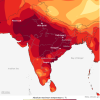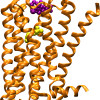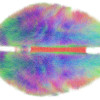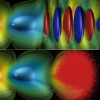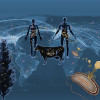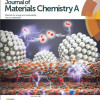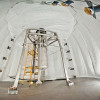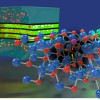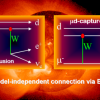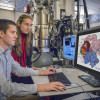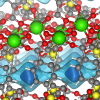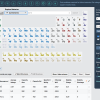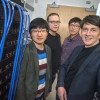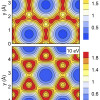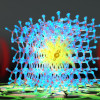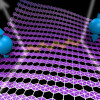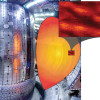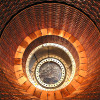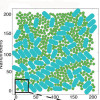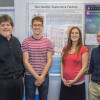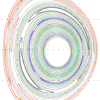Science News
Simulations Confirm Observations of 2015 India/Pakistan Heat Waves
A paper published December 15 during the American Geophysical Union (AGU) fall meeting in San Francisco points to new evidence of human influence on extreme weather events. Three researchers from Berkeley Lab are among the co-authors on the paper, "The Deadly Combination of Heat and Humidity in India and Pakistan in Summer 2015," which examined observational and simulated temperature and heat indexes and concluded that the two separate heat waves "were exacerbated by anthropogenic climate change." Read More »
Supercomputers Help ID New Drug Leads to Fight Heart Disease
Using a unique computational approach to rapidly sample proteins in their natural state of gyrating, bobbing and weaving, researchers have identified promising drug leads that may selectively combat heart disease. Read More »
Global Brain Initiatives Generate Tsunami of Neuroscience Data
Around the world, various 'Brain Initiatives' are generating a tsunami of neuroscience data. But without a coherent strategy to analyze, manage and understand the data, advancements in the field will be limited. That's why Berkeley Lab's Kristofer Bouchard assembled an international team of interdisciplinary researchers, including NERSC staff, to overcome the big data challenge. Read More »
Multiscale HPC Captures Photovoltaics at the Nanoscale
Advances in ultrafast spectroscopy experiments and high performance computing are revolutionizing the scientific community’s ability to study the physical processes that occur in solar cells at short length and time scales. Read More »
The Incredible Shrinking Particle Accelerator
WarpIV, a new data analysis/visualization toolkit developed at Berkeley Lab, is designed to help speed particle accelerator research and design by enabling in situ visualization and analysis of accelerator simulations at scale. Read More »
Researchers use Edison to Improve Performance, Energy Efficiency of Bioinformatics Application
A team of computer scientists and geneticists from Iowa State University, the University of Maryland and the University of Arkansas have demonstrated significant speedups of the epiSNP bioinformatics program using the Edison supercomputer at NERSC. Read More »
Unveiled: Earth’s Viral Diversity
Researchers from the Joint Genome Institute utilized the largest collection of assembled metagenomic datasets from around the world to uncover over 125,000 partial and complete viral genomes. Read More »
Toward Cost-Effective Polymer Electrolyte Fuel Cells
A research team running density functional theory calculations at Berkeley Lab's NERSC center has demonstrated how polymer electrolyte fuel cells—long favored for transportation applications—can be made to run more efficiently and produced more cost-effectively by reducing the amount of a single key ingredient: platinum. Read More »
World’s Most Sensitive Dark Matter Detector Completes Search
The Large Underground Xenon (LUX) dark matter experiment, which operates beneath a mile of rock at the Sanford Underground Research Facility in the Black Hills of South Dakota, has completed its search for the missing matter of the universe. Read More »
Supercomputers Help Identify Efficiency-Limiting Defects in LEDs
Using state-of-the-art theoretical methods, researchers at the University of California Santa Barbara have identified a class of point defects that act as sites for nonradiative recombination and can explain the observed reduction in efficiency of nitride-based light emitting diodes. Read More »
A Peek Inside the Earliest Moments of the Universe
Researchers from the NPLQCD Collaboration used LQCD calculations to better understand the big bang nucleosynthesis process, which occurred in the first few minutes following the Big Bang, and precisely measure the nuclear reaction rate that occurs when a neutron and proton form a deuteron. Read More »
Cryo-EM’s Renaissance
In a pair of breakthrough Nature papers published last month, researchers in Eva Nogales’ Lab at UC Berkeley mapped two important protein functions in unprecedented detail. And they used supercomputers at NERSC to process and analyze the data. Read More »
Models Help Pinpoint Material for Better Nuclear Fuel Recycling
A team of computational scientists sifted 125,000 molecules to pinpoint one ideal for separating some radioactive gases from spent nuclear fuel, then another team synthesized and tested it. Read More »
New Mathematics Accurately Captures Liquids and Surfaces Moving in Synergy
Berkeley Lab researchers in the Computing Sciences Division have developed a new mathematical framework that allows researchers to capture fluid dynamics at unprecedented detail. The work could be used in a range of applications, like optimizing the shape of a propeller blade and the ejection of ink droplets in printers. Read More »
Materials Project Releases Massive Trove of Battery and Molecule Data
The Materials Project, a Google-like database of material properties aimed at accelerating innovation, has released yet another trove of data to the public that will help researchers working on batteries. Read More »
New Path Forward for Next-Generation Lithium-Ion Batteries
Using supercomputers at NERSC, researchers report a major advance in understanding how oxygen oxidation creates extra capacity “lithium-rich” cathodes, opening the door to batteries with far higher energy density, meaning your phone or electric vehicle will be able to run for much longer between charges. Read More »
Warm Dense Crystallography: Digging Deeper into WDM
Researchers from the University of Washington are using NERSC supercomputers and data from X-ray free-electron laser experiments to gain new insights into warm dense matter (WDM), one of the most challenging aspects of contemporary plasma physics. Read More »
Could Aluminum Nitride Produce Quantum Bits?
The leading method for creating quantum bits, or qubits, currently involves exploiting the structural defects in diamonds. But using NERSC resources, University of Chicago researchers found that the same defect could be engineered in cheaper aluminum nitride. If confirmed by experiments, this could significantly reduce the cost of manufacturing quantum technologies. Read More »
2D 'Flat' Boron Yields a Superconducting Surprise
Density functional theory simulations run at NERSC helped Rice University researchers determine that two-dimensional boron is a natural low-temperature superconductor. Read More »
NERSC Resources Help Find Roots of MJO Modeling Mismatches
Researchers from Pacific Northwest National Laboratory are using field data and NERSC supercomputers to better model how the Madden-Julian Oscillation (MJO) operates and gain new insights into the impact of a warming climate on the MJO. Read More »
Could Material Defects Actually Improve Solar Cells?
Scientists at the National Renewable Energy Laboratory are using supercomputers to study what may seem paradoxical: certain defects in silicon solar cells may actually improve their performance. Read More »
Multi-Scale Simulations Solve a Plasma Turbulence Mystery
Cutting-edge simulations run at NERSC over a two-year period are helping physicists better understand what influences the behavior of the plasma turbulence that is driven by the intense heating necessary to create fusion energy. Read More »
Updated Workflows Enhance New LHC Era
Researchers working on ATLAS, one of the Large Hadron Collider’s largest experiments, are using updated workflow management tools developed primarily by Berkeley Lab researchers to help sift through the increasingly large datasets being generated by the experimental facility. Read More »
Seeing the Big Picture in Photosynthetic Light Harvesting
To understand what goes on inside a beehive, you can’t just study the activity of a single bee. Likewise, to understand the photosynthetic light harvesting that takes place inside the chloroplast of a leaf, you can’t just study the activity of a single antenna protein. So researchers with Lawrence Berkeley National Laboratory and the University of California (UC) Berkeley created the first computational model that simulates the light-harvesting activity of the thousands of antenna proteins… Read More »
Supernova Twins: Making Standard Candles More Standard Than Ever
By employing a new modeling method, members of the international Nearby Supernova Factory based at Berkeley Lab were able to dramatically reduce the scatter in supernova brightnesses. Read More »
Physicists ID Mechanism that Stabilizes Plasma in Tokamaks
A team of physicists has discovered a mechanism that prevents the electrical current flowing through fusion plasma from repeatedly peaking and crashing, which can cause instabilities within the plasma's core. Read More »






